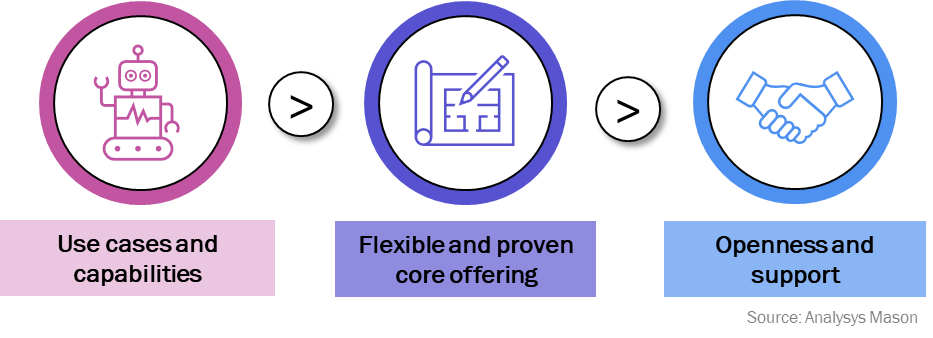5G standalone networks: how vendors can accelerate adoption
5G standalone (SA) is the next phase of 5G deployment for many operators. It marks the transition from 5G non-standalone (NSA) architecture, which uses the existing 4G evolved packet core (EPC), towards a self-supporting and flexible 5G core. As well as no longer relying on a 4G anchor for control, the transition to 5G SA also opens the door to a range of network benefits, especially when leveraging a cloud-native core. These benefits include the cost, scalability and agility advantages of a cloud environment, but also a range of unique network capabilities, such as ultra reliable low-latency communication (URLLC), massive IoT, improved edge support and network slicing. However, adoption has been slow to date, and barriers need to be lowered to unlock revenue for operators and vendors.
This article is based on Analysys Mason’s recent report, 5G standalone: vendor strategies to accelerate adoption.
The coming years will be a critical time for 5G SA adoption, but operator concerns may delay progress
The advanced capabilities of 5G SA can bring a range of cost savings and performance advantages to an operator network, and most importantly, the 5G core could enable new use cases and monetisation opportunities for operators. This particularly relates to network slicing, which is a flagship capability of 5G SA, and allows operators to create and monetise customised virtual slices of their networks with guaranteed performance and unique service level agreements (SLAs) to support specific customers’ or applications’ requirements.
The 5G core can give enterprises access to the network, to customise functionality within their own slice. This creates the potential for new B2B revenue for operators and could drive significant network innovation by specialist enterprise developers. Considering the difficulty operators have had in monetising quality of experience (QoS) gains from their 5G NSA networks, 5G SA offers an important potential for new revenue.
Despite the benefits that 5G SA can bring to operator networks, the transition has been slower than core suppliers hoped. As of 2022, only 19% of total vendor core revenue came from 5G SA, with progress being slowed by operator concerns about use cases, migration disruption and technology maturity.
Operator concerns surrounding technology maturity, the disruption of migration and unclear use cases are slowing 5G SA adoption
5G SA can enable new service models but operators are often uncertain about the scale of demand and therefore the return on investment. Many operators are facing the sunk costs of recent investments in 5G NSA and are unwilling to adopt 5G SA because the monetisation opportunities are not clear. However, this hesitation creates its own challenge, with their lack of adoption slowing innovation in new 5G services. At the moment, many advanced 5G applications are in their infancy and this adds to uncertainty for operators.
Technology maturity in the 5G core is also a concern. In Analysys Mason’s 2023 operator survey, over 50% of respondents chose this as a critical barrier to their adoption of 5G SA. Reliability and performance are vital considerations, and any technology issues in the 5G core could cause service degradation over wide areas. This is particularly the case during migration phase, where operators face the most risk to service performance and can encounter issues relating the running of old and new cores together.
Other technology concerns relate to the maturity of 5G SA’s most important capability, network slicing, since platforms to support effective slice management and monetisation are unproven. The fragmented state of network application programming interfaces (APIs) is also a key consideration, with greater openness and unification needed to drive increased developer innovation on the network.
As well as the transition to 5G SA being seen as a significant technology risk, the entire process, as well as the long-term running of the new 5G core and its monetisation, requires new skills and knowledge for operators. Operators need to build new skillsets in the cloud before starting their migration while also transforming their sales and support strategy to target new customer types in enterprise.
All of these perceived risks are slowing 5G SA adoption, curtailing 5G innovation and delaying vendor revenue opportunities.
Vendors can help to accelerate 5G SA by prioritising use cases and proving a scalable and flexible core offering that drives innovation
Figure 1: Key considerations for the acceleration of cloud-native 5G core adoption

At a technology level, vendors can encourage operators to migrate to 5G SA more quickly by providing a robust and reliable core platform that targets and prioritises the new 5G capabilities that are most important for operators, because they uniquely address proven areas of demand. Vendors also need to prove that they can offer a scalable, hybrid core solution that effectively supports these capabilities, eases the transition to 5G SA, and minimises the risk and disruption of migration.
Monetisation is one of the most important considerations for operators, and as well as proving their core technology, vendors should help to prove the business case to support applications that rely heavily on the 5G core. By driving case studies, test beds, frameworks and best practices, vendors can build confidence in 5G SA monetisation and functionality. Vendors with experience of the enterprise market should use their technical knowledge and B2B experience to support operators in navigating enterprise markets and ecosystems. This support should also extend to a broad range of ecosystem partners. Specifically, vendors need to provide third-party developers with the unified APIs, tools and support that will encourage their innovation on the network.
Across all of these areas, support, collaboration and knowledge sharing will be vital. Vendors need to use their unique position to bridge the operator skill gap, while also considering how to support the broader ecosystem. Vendors should support operators by proving the technology and its monetisation, and also by offering more direct training and technical support. However, vendors should also consider a wide range of other partnerships, such as with application developers, device/sensor manufacturers or even other core vendors, that can help to realise the technology and revenue opportunities.
Article (PDF)
DownloadAuthor

James Kirby
Senior AnalystRelated items
Survey report
Operators’ requirements for their next-generation RANs: survey results and analysis
Article
Stakeholders must collaborate to prove the security benefits of Open RAN and de-risk early deployments
Forecast report
Mobile packet core: worldwide forecast 2024–2030

